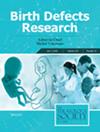Spontaneous Resolution of Molar Tissue in Complete Hydatidiform Mole With a Coexisting Fetus
Abstract
Background
Complete hydatidiform mole with a coexisting fetus (CMCF) is a rare form of twin pregnancy associated with high maternal and perinatal risks, posing complex diagnostic and therapeutic challenges. The standard approach ranges from termination of pregnancy to conservative management to fetal viability. Recent evidence suggests that spontaneous regression of molar tissue may occur, supporting conservative treatment in selected cases. We present a new case and discuss the clinical consequences of this phenomenon.
Case
We report a 29-year-old woman with a history of a previous molar pregnancy who presented with CMCF during her second gestation. The diagnosis was established at 21 weeks' gestation based on ultrasound findings and an elevated beta-hCG level of 454,000 mIU/mL. After multidisciplinary counseling, expectant management was indicated with close clinical, sonographic, and biochemical surveillance. By 30 weeks, significant regression in molar tissue was observed, and by 36 weeks, the appearance on ultrasound was like a normal placenta with decreased beta-hCG levels. At 37 weeks, a cesarean section was performed, resulting in the delivery of a healthy female infant weighing 2585 g. The placenta was normal and small, necrotic-appearing placental tissue. Histopathological analysis confirmed the presence of gestational trophoblastic disease with extensive necrosis.
Conclusions
This is the third reported case of spontaneous regression of molar tissue in CMCF, with resolution occurring in the third trimester. This finding opens a new perspective for the management of these complex pregnancies, suggesting that conservative strategies may be justified in selected patients under close surveillance.

 求助内容:
求助内容: 应助结果提醒方式:
应助结果提醒方式:


